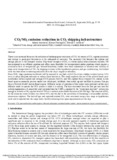JavaScript is disabled for your browser. Some features of this site may not work without it.
| dc.contributor.author | Awoyomi, Adeola | |
| dc.contributor.author | Patchigolla, Kumar | |
| dc.contributor.author | Anthony, Edward J. | |
| dc.date.accessioned | 2019-06-07T10:45:39Z | |
| dc.date.available | 2019-06-07T10:45:39Z | |
| dc.date.issued | 2019-06-04 | |
| dc.identifier.citation | Awoyomi A, Patchigolla K, Anthony EJ. (2019) CO2/SO2 emission reduction in CO2 shipping infrastructure. International Journal of Greenhouse Gas Control, Volume 88, September 2019, pp. 57-70 | en_UK |
| dc.identifier.issn | 1750-5836 | |
| dc.identifier.uri | https://doi.org/10.1016/j.ijggc.2019.05.011 | |
| dc.identifier.uri | http://dspace.lib.cranfield.ac.uk/handle/1826/14229 | |
| dc.description.abstract | There is an increased focus on the reduction of anthropogenic emissions of CO2 by means of CO2 capture processes and storage in geological formations or for enhanced oil recovery. The necessary link between the capture and storage processes is the transport system. Ship-based transport of CO2 is a better option when distances exceed 350 km compared to an offshore pipeline and offers more flexibility for transportation, unlike pipelines which require a continuous flow of compressed gas. Several feasibility studies have been undertaken to ascertain the viability of large-scale transportation of CO2 by shipping in terms of the liquefaction process, and gas conditioning, but limited work has been done on reducing emissions from the ship’s engine combustion. From 2020, ships operating worldwide will be required to use fuels with 0.5% or lower sulphur content (versus 3.5% now) or adopt adequate measures to reduce these emissions. This study explores the use of the solvent-based post-combustion carbon capture and storage (CCS) process for CO2 and SO2 capture from a typical CO2 carrier. A rate-based aqueous ammonia process model was developed, validated, then scaled up and modified to process flue gas from a Wartsila 9L46 F marine diesel engine. Different modes of operation of the carrier were analysed and the most efficient mode to operate the CCS system is during sailing. The heat recovered from the flue gas was used for solvent regeneration. A sensitivity study revealed that the 4 MWth supplied by the “waste heat recovery” system was enough to achieve a CO2 capture level of 70% at a solvent recirculation flowrate of 90–100 kg/s. The removal of SO2 by the ammonia water solution was above 95% and this led to the possibility of producing a value-added product, ammonium sulphate. The boil-off gas and captured emitted CO2 were recovered using a two-stage re-liquefaction cycle and re-injected into the cargo tanks, thereby reducing extra space requirements on the ship. | en_UK |
| dc.language.iso | en | en_UK |
| dc.publisher | Elsevier | en_UK |
| dc.rights | Attribution-NonCommercial-NoDerivatives 4.0 International | * |
| dc.rights.uri | http://creativecommons.org/licenses/by-nc-nd/4.0/ | * |
| dc.subject | Post-combustion carbon capture | en_UK |
| dc.subject | CCS | en_UK |
| dc.subject | Chemical absorption | en_UK |
| dc.subject | On-board carbon capture | en_UK |
| dc.subject | Marine propulsion engine | en_UK |
| dc.subject | Emission control | en_UK |
| dc.title | CO2/SO2 emission reduction in CO2 shipping infrastructure | en_UK |
| dc.type | Article | en_UK |
Files in this item
The following license files are associated with this item:
This item appears in the following Collection(s)
-
Staff publications (SWEE) [2807]

